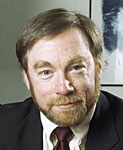Lecture by Brad Kalbfeld, former AP Managing Editor/ Broadcast
On Tuesday, April 5, 2011, Brad Kalbfeld stopped by George Mason University to talk to Online Journalism students. Kalbfeld is a digital pioneer. You can check out his website, Interactivity, LLC.
For more than 36 years, he has been a :
- writer
- reporter
- editor
- news executive
- including 22 as Managing Editor/Broadcast for The Associated Press.
Kalbfeld was responsible for AP’s broadcast wire, audio and domestic video operations and has produced coverage of such major events as 9/11, the wars in Afghanistan, Iraq and the Persian Gulf, two space shuttle disasters and five presidential elections.
He started out the lecture by showing off his laptop in the 1980’s. It was a typewriter. He then went on to show us his electronic laptop he got in the early 1990’s.
Kalbfeld’s description of the event. who is the source of a story (ie: Reporter or “Joe Six-Pack”) and how the information trickles down the .
The news event process is like this:
- Event happens
- Reporter OR “Joe Six-Pack” reports on it
- Copy Editor okays it
- Section Editor/ Show Producer okays it
- This can go straight to the Reader/Viewer OR go to a Managing Editor before going to the Reader/Viewer
A student in class, Melissa Sathmary said, “Citizen journalists have the opportunity to fabricate stories though, like Balloon boy.”
Responding Kalbfeld said, “Professional journalists are scared of citizen journalists. So there is a pressure to give more credence in their articles.”
Investigative journalism has changed in the past 36 years. “There is less money involved on the local level for investigative journalism. However, it is a great way to get attention. And if you do that enough, it’s a great business plan to make money. It is one of the chief ways investigative journalists can make enough money to make a living,” said Kalbfeld.
He wrapped up the lecture by saying, “The world is your new editor”.
Filed under Lecture | Comment (1)Lecture by Claudia Holland on copyright and fair use
George Mason University’s copyright officer, Claudia Holland visited with Klein’s Online Journalism class to talk about copyright and fair use on Thursday, February 3, 2011.
The lecture was Power Point based and started out with explaining that copyrighted traits are expressions and originality; protected works are literary, architectural, sounds recordings, motion pictures, and other picture, graphic or sculpture work. Among the list included things that are not protected by copyright; ideas, public domain, titles names, short phrases, and generally anything published before 1923.
Holland went on to explain that fair use was made to benefit the public. Some parts of copyrighted material can be used in particular instances. Four elements that need to be considered are:
- Purpose and character of use
- Nature of the work
- Amount and substantiality of the portion used (10% is rule of thumb)
- Effect of the use on the potential market
Safe harbor was talked about as well; when setting up a blog or website, the author needs to protect oneself. One way to share ideas without getting into hot water over copyrights would be through Creative Commons. Their logo explains it all, “Share, remix, reuse, legally!”
Filed under Lecture | Comment (0)